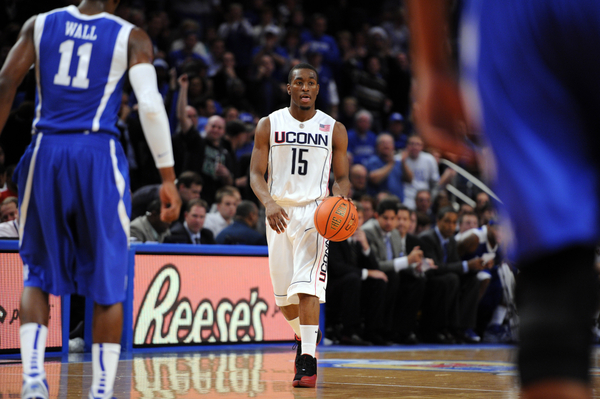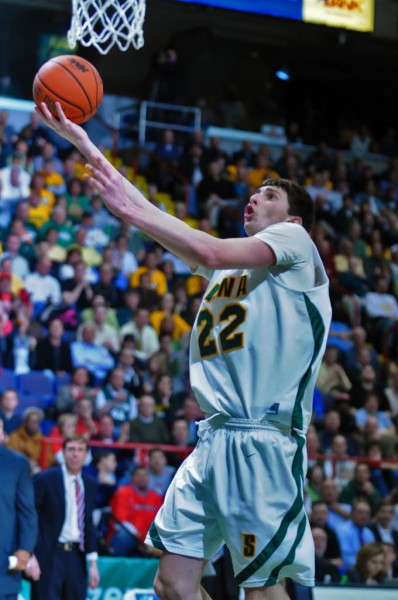RTC 2010-11 Impact Players – Northeast Region
Posted by rtmsf on October 4th, 2010It’s October. The leaves are starting to turn colors. Halloween candy is already in the stores. There have been a few nights where you may have even turned on the heat. Midnight Madness is less than two weeks away and RTC is ready to jump into the 2010-11 Season Preview materials headfirst, like a ten-foot stack of those leaves that you just raked into a giant pile. For the second October in a row, we’re going to bring you our RTC Impact Players series. The braintrust has gone back and forth on this throughout September and we’ve finally settled on a group of sixty players throughout ten geographic regions of the country (five starters plus a sixth man) to represent the who and where of players you should be watching this season. Seriously, if you haven’t seen every one of these players ball at least once by the end of February, then you need to figure out a way to get a better television package. As always in a subjective analysis such as this, some of our decisions were difficult; many others were quite easy. What we can say without reservation is that there is great talent in every corner of this nation of ours, and we’ll do our best to excavate it over the next five weeks in this series that will publish on Mondays and Thursdays. Each time, we’ll also provide a list of some of the near-misses as well as the players we considered in each region, but as always, we welcome you guys, our faithful and very knowledgeable readers, to critique us in the comments. We begin in the top right corner of the country also known as the Northeast.
Northeast Region (ME, NH, VT, MA, RI, CT, NY)
- Kemba Walker – Jr, G – Connecticut. Kemba Walker is a two-time RTC Impact Player, as he was slotted in this position prior to his sophomore campaign last season. Many, ourselves included, expected the exceptionally quick point guard to have a breakout 2009-10 season that would result in the NBA Draft come June, but like the entire UConn program last season, things didn’t work out exactly as planned. He’s your classic Boogie Down point guard in that he carries himself with a swagger borne on the playgrounds of New York City, he looks to attack the goal first and foremost off the bounce, and he often exhibits problems subjugating his own scoring in favor of keeping everyone else involved. Still, there’s no denying the pure talent Walker possesses — he’s virtually unguardable in the open court with the ball in his hand, and his scoring (14.6 PPG), passing (4.9 APG), defense (2.1 SPG) and outside shooting (34% 3FG, up 7%) have all improved. One problem area was that he was a turnover machine in the first half of last season (totaling 69 miscues through January 23), but after that the light appeared to click on and he cleaned up his handle the rest of the way with nine games of two TOs or fewer. Even if he’s learned the value of possession, though, there are still areas of concern. As the lead guard taking over for AJ Price last season, he presided over the tumultuous team chemistry of a proud program that suffered one of its worst seasons in Jim Calhoun’s tenure at UConn. Also troubling was that his renowned ability to get to the rim and finish at a high rate fell off considerably (52% as a freshman; 43% last year), suggestive of greater defensive focus placed on him and a tendency to over-penetrate. NBA draftniks still like Walker as a late first-rounder when he decides to come out, so if he can finally make the expected leap from a very good collegiate point guard to a great one, expect to see him standing tall with David Stern on the stage at MSG next June (he is also on track to graduate in May 2011).
- Charles Jenkins, Sr, G – Hofstra. For the Hofstra Pride, it begins and ends with Jenkins. After getting over some early season injuries last season, Jenkins took over and led his team in scoring in 16 of its last 18 games. He was the only player on the team to average double figures last season (20.6 PPG), and was clearly their go-to player in almost every situation. As a result, he’s earned plenty of accolades, bringing home last season’s CAA Player of the Year award as well as taking home his second straight Haggerty Award (presented to the best player in the New York Metropolitan area) and earning an Associated Press All-American honorable mention. He’s on track to wrap up his career on Long Island as the school’s all-time leading scorer, but he is also currently eighth on the school’s all-time assist list as well, a testament to just how much he does for this team. For a Pride squad that only returns three players that averaged more than two points per game last season (senior center Greg Washington and senior swing Nathaniel Lester are the other two), Jenkins will need to pick right back up where he left off last season when he scored 20 or more in the last nine games. Jenkins will play a ton of minutes (he played 39 or more minutes 18 times last season), take a bunch of shots (only once against a D1 opponent last season did he fail to take more than ten field goal attempts), and he’ll score plenty of points in a variety of ways. While he is an excellent three-point shooter (hitting 41% from deep last year – a nice improvement from his first two seasons), Jenkins is at his best when he puts the ball on the floor and gets into the lane, scoring with a variety of moves, creating easy looks for teammates or, ideally, drawing fouls and getting to the line where he excels as an 80-plus percent shooter. Jenkins has shown an ability over his career to play heavy minutes and carry the load of expectations without wearing down, and he’ll need to do it all one more time for the Pride to compete with teams like Old Dominion, Virginia Commonwealth and George Mason for a CAA title and Jenkins’ first NCAA Tournament bid in an otherwise outstanding college career.
- Joe Trapani, Sr, F – Boston College. After arriving in Chestnut Hill with a great deal of hype following his transfer from Vermont after his freshman year, Joe Trapani has proven to be a vital cog in the Eagles program the past two years. With the departure of the dynamic Tyrese Rice after the 2008-09 season, the Eagles needed Trapani to step up his game with opposing defenses putting an increased focus on him as they no longer had to deal with Rice’s erratic, but deadly scoring ability. Trapani fulfilled the Eagles’ need to an extent as his scoring increased slightly (from 13.4 PPG to 14.1 PPG), but he did not show the development that many expected of him and the forward who was once considered a potential NBA prospect (think journeyman not starter) is instead now looking at a career in Europe. Trapani remains a versatile forward who can rebound and score from both inside and beyond the arc, but he will have to adapt his game while transitioning coaches from Al Skinner to Steve Donahue while taking on an increased leadership role if the Eagles are to return to the NCAA Tournament (after making it there five times in six years before last year’s 15-16 campaign). The strange departure of Rakim Sanders will make Trapani’s maturation even more vital to the Eagles’ chances of becoming relevant in the ACC again. Trapani has displayed moments of brilliance (witness his 31 point, 6 rebound effort in a win at Miami and his 11 point, 12 rebound game in a win at Michigan), but has too often been riddled by inconsistency as evidenced by his numerous poor performances (5 points on 1-13 shooting in another game against Miami, 9 points on 4-12 shooting against South Carolina , 8 points on 2-7 shooting against Duke, 6 points on just 5 field goal attempts against Virginia Tech , 8 points on 3-11 shooting against UNC , and 2 points on 0-7 shooting against Virginia in the final game of the season). If Trapani can become a more consistent player in his senior season as an Eagle it might be enough to make Donahue’s first season in the ACC as successful one and put the Eagles back in the hunt in the ACC.
- Ryan Rossiter, Sr, F – Siena. Chances are, if you’ve seen a Siena basketball game in the last couple of years, you’ve been told to watch Alex Franklin or Kenny Hasbrouck or Edwin Ubiles. All fine players, they. But there’s also a good chance that while you were watching that game and focusing on those three excellent Saints, your eye was caught by Ryan Rossiter and you were equally impressed. His name is called a lot. He’s the guy you see fighting for rebounds he had no realistic chance at getting. His is the hand that always seems to make that critical late-game back-tap or find its way into opponents’ passing lanes. He’s the fellow with the freshest floor burns. Heck, you can’t help but like him. Yes, it’s a cliche to say a player does the “little things” to help his team win, but sometimes it’s an apt description, and this is one of those times. The 6’9, 234-pound Staten Island native has been every bit as important as those aforementioned Siena stars in helping the Saints win 75 games over the last three seasons, chalk up three straight MAAC Tournament titles, and become the official Team You Don’t Want To See As Your First Round Opponent (Vanderbilt and Ohio State can vouch). He may not have historically gotten a lot of pre-season or even pre-game hype, but the MAAC gave him his post-season props last year, naming him to the conference’s first team. He may have always been that “little things” type of player, but last year he decided to take on some of the bigger chores as well, like average 13.8 PPG, 11.1 RPG (tops in the MAAC and sixth in the nation), shoot 57.1% from the field (second in the MAAC, five points lower than 2008-09, when he led the nation in FG% as a sophomore), snag 1.4 SPG, and post 22 double-doubles in 34 games, with 20 of those coming in Siena’s final 24 contests. This year is different, though. It’s his team. He’s the conference POY candidate, not one of teammates like in previous years. I wouldn’t worry, Saints fans. Rossiter knows better than anyone that, even if he happens to be getting the hype now, it’s still all about family at Siena. Sure, they might have a few cuts and floor burns on them, but your team is in good hands.
- Kris Joseph, Jr, F – Syracuse. How is a team that lost three of their top four scorers, including a top-five pick, projected to contend for the top three in the Big East a season later? One huge reason is the expected improvement of Kris Joseph, a probable future first round selection and conference sixth man of the year award winner in 2009-10. The Montreal native could end up breaking out in Wes Johnson fashion as Jim Boeheim’s starting small forward. Joseph is an exceptional athlete with tremendous leaping ability and an improving mid-range jumper. An aggressive, no-nonsense scoring wing with every physical tool necessary to excel in the Big East, Joseph’s game-icing bucket at Georgetown last season is just a glimpse of what the orange-clad thousands that pack the Carrier Dome can expect in 2010-11. Boeheim also loves his 6’7 junior because of a motor that never stops running, whether it’s grabbing a key offensive rebound, completing a tip-in or just being active in the patented 2-3 zone. Joseph compiled fantastic performances against Providence (23 points, 9-11 FG, 5-5 FT, 7 rebounds), against top ten Villanova (16 points, 5-12 FG) and in the Big East Tournament loss to Georgetown (18 points, 6 rebounds, 7-10 FG). Along with a quick first step that allows Joseph access to the rim and will remind Syracuse fans of his predecessor at the wing, Joseph also has the capabilities to step in adequately on the defensive end of the floor with that impressive wingspan. With such a wealth of talent, why hasn’t Joseph stumbled onto stardom already? One reason is the supporting cast around him — from Jonny Flynn to Eric Devendorf to Paul Harris to Andy Rautins to Arinze Onuaku to Wes Johnson — that hasn’t provided Joseph an ample number of possessions to show his worth. Another is because Joseph is still raw on the floor with a basketball IQ that’s far from advanced and a perimeter jump shot suspect enough that defenders tend to lag off of him. With the possibility of playing 35-38 minutes per game for a team that may have the most talent in the perennially loaded Big East, Joseph can simply correct these flaws with increased experience on the floor. On a team that lost three starters yet hasn’t noticed preseason expectations take a dramatic dip, Joseph won’t only be relied on for more minutes, but more production and leadership in 2010-11. The jury’s out on whether he’s up to the challenge.
- Fab Melo (6th), Fr, C – Syracuse. In August 2009, Fabricio Melo made it official — there would be another Melo Era in Syracuse. One year later, the Brazilian import and gem of Jim Boeheim’s stellar 2010 recruiting class is the early favorite to reign supreme as Big East Freshman of the Year. Melo, ESPN’s top-ranked center in the class of 2010, is expected to step in alongside Rick Jackson on the Orange starting frontline as one of the premier rookies in the country. A legitimate seven feet and around 270 pounds, the loss in height and bulk with the graduation of Arinze Onuaku will be replaced by the big-bodied South American import (not to mention a potential for Twin Towers if Melo sticks around for a sophomore season and teams with 2011 center Rakeem Christmas). Melo is an instant offensive upgrade from Onuaku, whose lofty FG% numbers were largely due to elite guard play getting him the ball at the rim and limited attempts. The freshman is blessed with hands made of glue, a rare commodity for an 18-year old seven foot center, and is one of the best low post scorers in his class. Out of shape as a young high school player, Melo has committed himself the last two seasons to trimming down and molding himself into a big man prepared for the rigors of physical Big East competition. Melo should also fit in well with the 2-3 zone that Syracuse employs due to his big frame clogging up space in the post and limited penetration opportunities for guards. Another reason Melo may have it easier than most freshmen entering such a rigorous conference is because of how the Big East projects to be a guard-oriented conference in 2010-11. Take a peek at our 20 At the Top feature from over the summer; only Gus Gilchrist, Herb Pope (if he plays) and Yancy Gates are true college centers. This should make the maturation process for Melo much easier. Syracuse may still be the most talented team in the conference despite substantial personnel losses and a gigantic reason why is the addition of Melo as an impact center, a legitimate low block presence that could average close to a double-double in his debut campaign.
Near-Misses
- Scoop Jardine – Jr, G – Syracuse. Last season’s national Sixth Man of the Year (according to the Sporting News) doesn’t wow you with fancy moves or highlight-reel plays very often, but he consistently does just about everything well.
- John Holland – Sr, F – Boston University. This two-time all-America East first-teamer led the conference in scoring (19.2 PPG) and was tenth in rebounding (6.1 RPG) in 2009-10.
Others Considered (* denotes injury or suspension)
- Greer Wright – Sr, F – Binghamton
- Reggie Jackson – Jr, G – Boston College
- Noruwa Agho – Jr, G – Columbia
- Chris Wroblewski – Jr, G – Cornell
- Derek Needham – Soph, G – Fairfield
- Chris Gaston – Soph, F – Fordham
- Joe Zeglinski – Sr, G – Hartford
- Kyle Casey – Soph, F – Harvard
- Scott Machado – Jr, G – Iona
- Gerald McLemore – Jr, G – Maine
- Rico Pickett – Sr, G – Manhattan
- Alvin Abreu – Sr, G – New Hampshire
- Chaisson Allen – Sr, G – Northeastern
- Marshon Brooks – Sr, F – Providence
- Justin Rutty – Sr, F – Quinnipiac
- Delroy James – Sr, F – Rhode Island
- Clarence Jackson – Sr, G – Siena
- Andrew Nicholson – Jr, F – St. Bonaventure
- Akeem Bennett – Sr, G – St. Francis (NY)
- DJ Kennedy – Sr, G – St. John’s
- Tommy Brenton* – Jr, F – Stony Brook
- Bryan Dougher – Jr, G – Stony Brook
- Brandon Triche – Soph, G – Syracuse














































